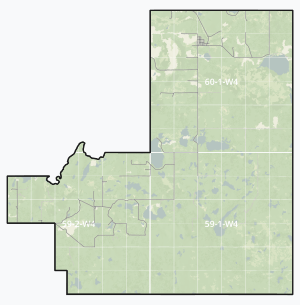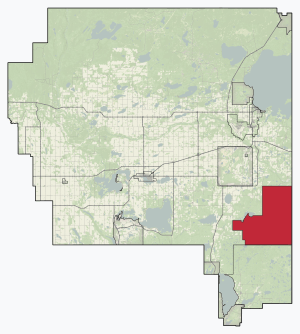Elizabeth Metis Settlement facts for kids
Quick facts for kids
Elizabeth
|
||
|---|---|---|
|
Métis settlement
|
||
| Elizabeth Métis Settlement | ||
|
||

Boundaries of Elizabeth
|
||

Location within M.D. of Bonnyville
|
||
| Country | Canada | |
| Province | Alberta | |
| Region | Northern Alberta | |
| Planning region | Lower Athabasca | |
| Municipal district | Bonnyville | |
| Area
(2021)
|
||
| • Land | 246.45 km2 (95.15 sq mi) | |
| Population
(2021)
|
||
| • Total | 594 | |
| • Density | 2.4/km2 (6/sq mi) | |
| • Summer (DST) | UTC−6 (MDT) | |
| Website | elizabethms.ca | |
The Elizabeth Métis Settlement is a special community in central Alberta, Canada. It is one of several Métis settlements created for Métis people.
This settlement was founded in 1939. It was part of a plan to help Métis families find a place to live. Elizabeth is about 20 kilometers (12 miles) east of Highway 897. It is also about 39 kilometers (24 miles) south of Cold Lake. The settlement covers a large area of land, about 25,641 hectares. Many people in the settlement work in industries like oil, gas, forestry, and construction.
Contents
History of the Elizabeth Métis Settlement
What Does Métis Mean?
The word "Métis" comes from a French term. It describes a person with mixed heritage. In western Canada, it usually means someone with both Indigenous and European roots.
How the Settlement Started
The Elizabeth settlement is one of ten Métis settlements. These communities were created in 1939. This happened because of a law called the Métis Betterment Act of 1938.
Before this, many Métis people in Manitoba did not have land. In 1871, the government promised land to married Métis individuals. Each person was supposed to get 160 acres. But too many people applied, and many did not get their promised land. Instead, they often received a small amount of money.
These land problems led to the famous Northwest Rebellion in 1885. Métis people fought against the Canadian government. After the battles, many Métis had to leave their homes. They were left without a safe place to settle.
The Métis Betterment Act
For over 50 years after the 1885 rebellion, many Métis groups had no land. In 1932, the Métis Association of Alberta was formed. Its members were former Métis political leaders. They convinced the Alberta government to look into the poor living conditions of Métis groups.
Because of their efforts, the Alberta government passed the Métis Betterment Act in 1938. This law helped create several settlements for Métis groups. A total of twelve settlements were first planned. These included Buffalo Lake, Cold Lake, East Prairie, Elizabeth, Fishing Lake, Gift Lake, Kikino, Marlboro, Paddle Prairie, Big Prairie, Touchwood, and Wolf Lake.
Changes in the 1930s to 1960s
When the settlements first started, their main goal was to improve life for Métis groups. The idea was that the settlements would be managed by a constitution, elections, and meetings. This would allow both the people and the local government to make decisions.
However, the way things actually worked was different. The government and the church had more control. This became even clearer after 1940. Changes to the Métis Betterment Act gave the government more power. This meant Métis people had less say in how their settlements were run.
Regaining Control: The Alberta Federation of Métis Settlements
After many years of changes to laws and a lack of self-government, Métis activists took action. In 1975, they created the Alberta Federation of Métis Settlements. Their main goal was to get back control of their communities and land.
After decades of legal struggles, the Federation finally succeeded. The Alberta government passed several important laws. These included The Métis Settlements Act and The Métis Settlements Land Protection Act. With these new laws, Métis people in the settlements gained control of a large area of land. This was about 152,121 hectares.
Population of Elizabeth Métis Settlement
The Elizabeth Métis Settlement is a "designated place" for counting people. In the 2021 Census, 594 people lived there. They lived in 189 homes. This was a small decrease from 653 people in 2016.
The settlement covers about 246.45 square kilometers of land. This means there were about 2.4 people living in each square kilometer in 2021.
A local count in 2018 showed 639 people. This was also a decrease from 690 people in 2015.
Culture of the Métis People
The culture in the Elizabeth Métis Settlement is unique. It blends Indigenous traditions with European backgrounds. For example, the jig is a traditional dance. The fiddle is a traditional instrument. Both came from European cultures.
The Métis Sash
The Métis sash is an important cultural item. It is a long wool belt, about 3 meters (10 feet) long. It is made by hand. Men often wear it as a belt. Women sometimes wear it over their shoulder.
Originally, the sash helped keep coats closed. Today, it is used in different dancing ceremonies. The sashes have many colors and designs. These designs can be different depending on where the sash was made.
Languages Spoken in the Settlement
The three most common languages spoken in the Elizabeth Métis Settlement are English, French, and Cree.
Before the 1900s, many Métis people spoke a special language. It was a mix of French and Cree called Michif. This language started around French trading posts in the 1600s and 1700s. These posts were near the Great Lakes. When tribes moved west and north, they took this language with them. This is why it developed differently from other French dialects in Canada.
After the Northwest Rebellion in 1885, Michif began to decline. It became forbidden to speak Indigenous languages in schools. Today, fewer than 1,000 people speak Michif fluently. Most fluent speakers are over 60 years old. This means the language is in danger of disappearing.
Religion in the Community
Most Métis people follow some form of Catholicism. This can be traditional Roman Catholic. It can also be a mix of Indigenous beliefs and Catholicism. There is one Roman Catholic church in the Elizabeth Métis Settlement. It is located next to the settlement's elementary school.


